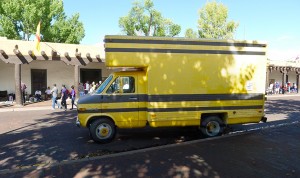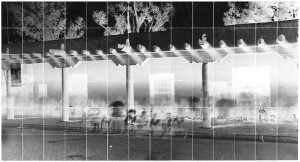During the 2012 Worldwide Pinhole Photography Day, Heather Oelklaus, a photographer and print workshop supervisor at Colorado College, was talking with some friends about the wonders of capturing the world the old-fashioned way. One of them asked her about the largest pinhole camera she’d ever used. At that point, it was an aluminum trash can that required two pieces of 16×20” photo paper for film. But the question made her want to go even bigger.
“I proclaimed that by next year’s pinhole day, I would be shooting with a truck,” she said.
 It took some scouting around before she found a 14-foot 1977 Chevy box truck with an uncanny resemblance to a yellow Kodak film box. She tackled drilling, painting, designing and light-tighting it while her imagination reeled out possible photo opps. In 2013, the newly designed pinhole truck, dubbed Little Miss Sunshine, took to the open road, shooting enough images to stage a show this year at the Sangre de Cristo Arts Center in Pueblo, Colo.
It took some scouting around before she found a 14-foot 1977 Chevy box truck with an uncanny resemblance to a yellow Kodak film box. She tackled drilling, painting, designing and light-tighting it while her imagination reeled out possible photo opps. In 2013, the newly designed pinhole truck, dubbed Little Miss Sunshine, took to the open road, shooting enough images to stage a show this year at the Sangre de Cristo Arts Center in Pueblo, Colo.
By then, Oelklaus (learn more about her by clicking here) had fallen in love with our exhibit, Poetics of Light: Pinhole Photography. “When I saw it the first time, I wept,” she said. “It sounds melodramatic, but to know there were people and a museum that understood what I loved about pinhole photography overwhelmed me.”
Photo Curator Daniel Kosharek and Palace Press Curator Tom Leech found out about her big truck and hatched a plot to shoot our beloved Palace of the Governors.
 This fall, Oelklaus arrived on a beautiful morning and recruited nine people to place 84 pieces of black-and-white darkroom paper on the truck’s walls, using tiny magnets. The Palace was exposed for 60 minutes, then the sheets were taken into a darkroom to develop.
This fall, Oelklaus arrived on a beautiful morning and recruited nine people to place 84 pieces of black-and-white darkroom paper on the truck’s walls, using tiny magnets. The Palace was exposed for 60 minutes, then the sheets were taken into a darkroom to develop.
“As the prints were coming out of the darkroom, many of the participants enjoyed putting the large-scale puzzle together so we could see the fruit of our labor,” she said.
We’re now looking for the perfect place to display the 5×20’ image, a grand celebration of pinhole artistry.
“The outside world squeezing through this tiny aperture and being projected on the inside of my camera truck inspires me,” Oelklaus said. “Recording the world differently and over long periods of time is a main theme for my recent work.”

